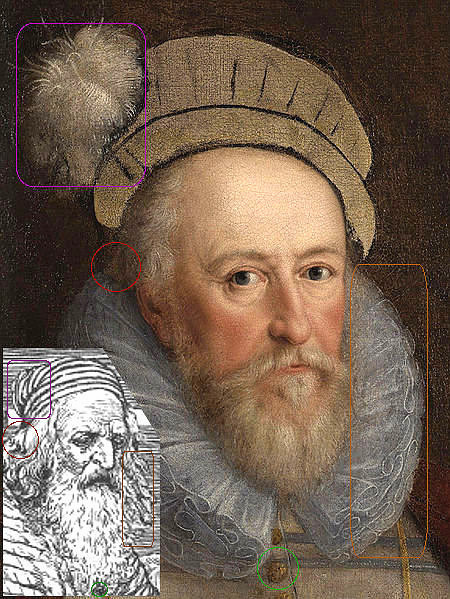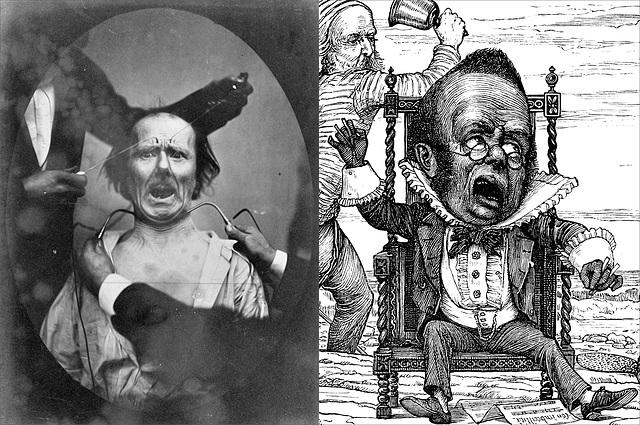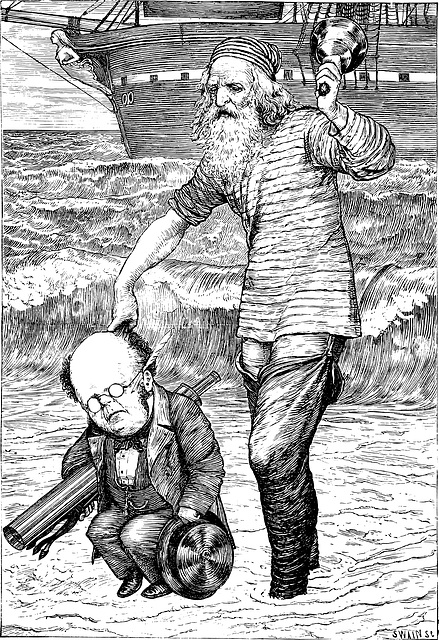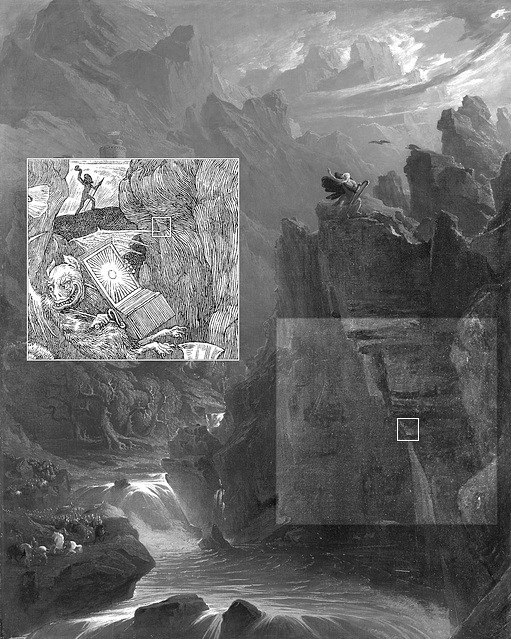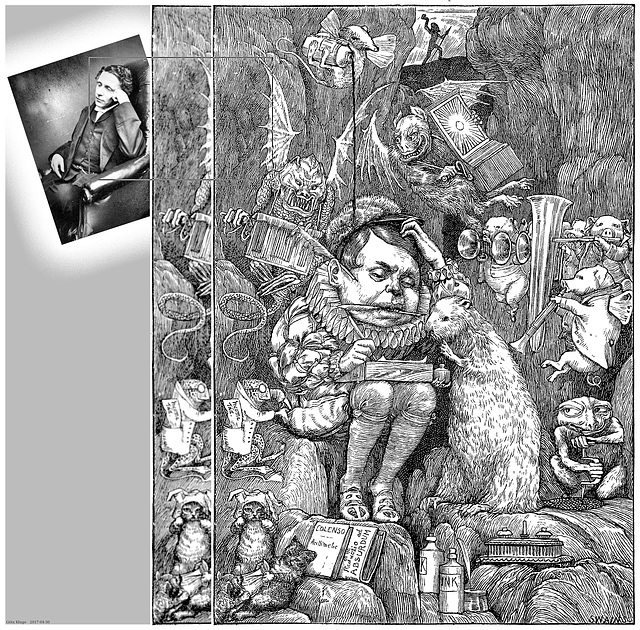
The Bellman
Folder: The Hunting of the Snark
03 Apr 2010
1 favorite
3 comments
William III, Religion and Liberty, Care and Hope
The color markers in both images show, to which pictorial elements in a 1674 print Henry Holiday alluded in his illustration to Lewis Carroll's The Hunting of the Snark (lower image, 1876) in the chapter The Hunting . The print (upper image by an anonymous artist, redrawn by me) is the orartie van de Professor L. Wolsogen over syndroom en de nytlegging van de felue gadaen ... . The animals in that print are based on illustrations by M. Gheeraerts the Elder to Aesop's Fables. (The print now is located at British Museum, BM Satires 1047, reg.no.: 1868,0808.3286 . A scan of the original print showing more details can be obtained from the museum.)
Holiday alluded to that 1674 image depicting William III as well as the allegorical figures for "religion" and "liberty". He discussed with Dodgson (Carroll) about the possible allegorical depiction of "care and hope". Interestingly, the two female members of the hunting crew also are quite similar to the allegories of "religion" and "liberty" shown in the 1674 print, the conflict between both probably being also conflict for the reverend Dodgson.
I made this image in the year 2010. The little inset with the yellow frame was my first presentation (2009-07-09) of the comparison.
16 Nov 2014
2 comments
Recycled Bellman Draft
In an early draft to the image The Crew on Deck , the Bellman had a different face than the one which the Bellman had in the final illustration. Henry Holiday moved that round faced character to the illustration The Barrister's Dream and then turned the Bellman into a Darwin look-alike.
18 Dec 2014
2 comments
The removed "error" had a purpose
In a 1910 edition of The Hunting of the Snark , an alledged error, which is not an error, had been removed. However, the removed white spot had a reason, as you see in the inset. The inset shows a segment from a 1876 edition with the white spot and a segment from The Bone Player (1856) by William Sidney Mount with a white spot (depicting a reflection from a glass).
22 Jan 2015
1 favorite
2 comments
The Expression of Emotions
To me, the Bellman 's arm (upper left corner in the right image) always looked strangely rounded. But obviously there are arms like that. It took me a long time (until today) to get the idea that also these two images could be related although I know Duchenne's photo (shown here in mirror view) since a couple of years.
www.evolutionnews.org/2012/05/creepy_ghoulish059671.html
"Creepy," "ghoulish," "not the best science" -- these are a few indisputable descriptions applied (by Wired magazine ) to an experiment Charles Darwin conducted in 1868. He was getting ready to write his book The Expression of the Emotions in Man and Animals and set out to sample reactions from all of 24 human subjects as they responded to and characterized a series of creepy, ghoulish photographs by French physiologist Benjamin Duchenne.
Charles Darwin didn't conduct these weird experiments. Duchenne did.
On the right side you see a detail from Henry Holiday's illustration to the chapter The Banker's Fate in Lewis Carroll's The Hunting of the Snark (1876).
The only known letter exchange between C. L. Dodgson (aka Lewis Carroll) and Charles Darwin was about photos of facial expressions, which Dodgson offered to Darwin (who kindly rejected the offer).
18 Apr 2015
1 favorite
1 comment
h10 - The Landing
10000 x 14598
Very large version of www.ipernity.com/doc/goetzkluge/19289465
05 Mar 2016
2 favorites
1 comment
Anthropomorphic Landscapes
I used this small image in a comment to publicdomainreview.org/collections/the-art-of-hidden-faces-anthropomorphic-landscapes
Antropomorphism isn't about faces only. Actually, humans have two pairs of cheeks. One pair of these cheeks is part of our faces. The other pair of cheeks is elswhere on our bodies. (If sitters are sitters, you don't see that pair too well.) In the example below from one of Henry Holiday's illustration to Lewis Carroll's "The Hunting of the Snark" (engraved by Joseph Swain) , Holiday wasn't inspired by John Martin's "The Bard" only. He also altered his allusion to that painting by giving the rocks the shape of our lower second pair of cheeks. And he also copied a small pattern from Martin's painting which doesn't contribute to the appearance of his illustration. Thus, this pattern simply may serve as a hint to the beholders of his Snark illustration that Holiday didn't steal anything from John Martin. Henry Holiday was an honest conundrum builder.
Did you find the antropomorphic "cheeks" on the rocks in the detail from Henry Holiday's illustration, which I mounted as an inset into John Martin's "The Bard"?
31 Aug 2017
2 favorites
4 comments
Carroll on the Rocks
Lewis Carroll, hidden in one of Henry Holiday's illustrations to Lewis Carroll's The Hunting of the Snark
Jump to top
RSS feed- Latest items - Subscribe to the latest items added to this album
- ipernity © 2007-2024
- Help & Contact
|
Club news
|
About ipernity
|
History |
ipernity Club & Prices |
Guide of good conduct
Donate | Group guidelines | Privacy policy | Terms of use | Statutes | In memoria -
Facebook
Twitter



